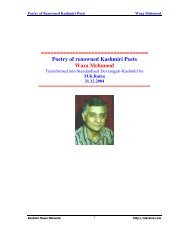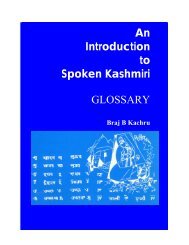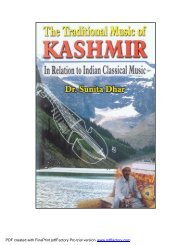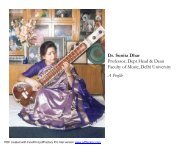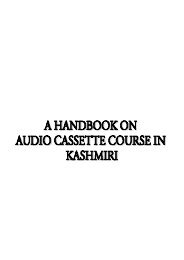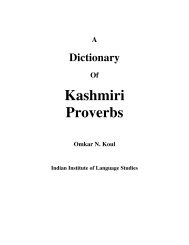Introductory Pages - An Introduction to Spoken Kashmiri
Introductory Pages - An Introduction to Spoken Kashmiri
Introductory Pages - An Introduction to Spoken Kashmiri
Create successful ePaper yourself
Turn your PDF publications into a flip-book with our unique Google optimized e-Paper software.
<strong>An</strong> <strong>Introduction</strong> <strong>to</strong> <strong>Spoken</strong> <strong>Kashmiri</strong><br />
by Braj B. Kachru<br />
The fricative sounds occur at the following places of articulation: (alveolar) s and z, (pala<strong>to</strong>alveolar)<br />
s;, and (glottal) h.<br />
Lateral<br />
s sath seven<br />
s?:r stroll, walk<br />
?:s <strong>to</strong> laugh<br />
z az <strong>to</strong>day<br />
z?ru:r certainly<br />
bo:zun <strong>to</strong> listen<br />
za:nun <strong>to</strong> know<br />
zana:n0 woman<br />
s; s;e six<br />
s;ik?:r Hindi-Urdu, shika:ra:<br />
k?:s;ur a kashmiri (mas.)<br />
pas; roof<br />
s;:kra:ce;a:r Shankracharya (temple)<br />
h hath one hundred<br />
hazratbal Hazratbal(mosque)<br />
hab0k?dal Habakadal (place name)<br />
hos elephant<br />
h’uhar father-in-law<br />
hke some, way<br />
In <strong>Kashmiri</strong>, there is one alveolar lateral, l. It is produced by <strong>to</strong>uching the teeth ridge with the tip<br />
of the <strong>to</strong>ngue, while the air passes out around the sides of the <strong>to</strong>ngue. The pronunciation is<br />
similar <strong>to</strong> that of the Hindi-Urdu l in la:l ‘red’ or the English ‘clear-l’ as in luck. It is not a ‘darkl’<br />
as in the English well or all.<br />
Trill<br />
l lac;h one hundred thousand<br />
la:ri: lorry, bus<br />
tsalun <strong>to</strong> runaway, <strong>to</strong> escape<br />
mal dirt<br />
ralun <strong>to</strong> mix, <strong>to</strong> mingle<br />
There is one trill, r, in <strong>Kashmiri</strong>. It occurs in the alveolar position, and it is similar <strong>to</strong> the Hindi-<br />
Urdu r in ra:t ‘night’ or ra:sta: ‘way’. It is a <strong>to</strong>ngue trill, produced by mildly tapping the blade of<br />
the <strong>to</strong>ngue against the teeth ridge.<br />
r ra:th yesterday<br />
© 2006 Braj B. Kachru (http://kachru.com) 19<br />
http://koshur.org/<strong>Spoken</strong><strong>Kashmiri</strong>



